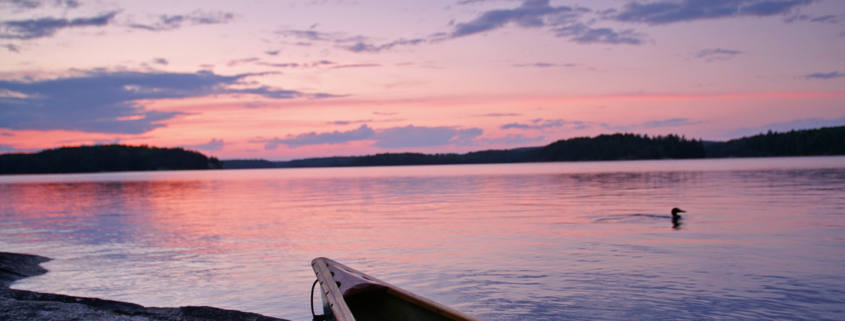Responsible Recreation: Canoes, Kayaks, and Loons
Is there anything better than exploring the lake on a sunny summer day? Self-powered vessels like canoes, kayaks, and stand-up paddleboards allow us to do just that. Paddling is a fun way to keep active in the summer, is a great way to get outside and enjoy nature, and can be enjoyed solo or with groups of family or friends. Given the physical, mental, and social benefits, it’s no wonder that kayaking, canoeing, and paddle boarding have been increasing in popularity in recent years.
From an environmental stewardship perspective, more people out enjoying nature is a great thing—in order for people to take steps to protect our ecosystems and wildlife, they first have to care about those ecosystems and wildlife. And what better way to develop care for our lakes than to get out on the water and experience them firsthand? However, while we’re out and about on lakes, it’s important for us to remember that wildlife can be affected by our presence. Although we typically think of motorboats as being the ones that negatively impact wildlife, self-powered boats like canoes, kayaks, and stand-up paddleboards can have just as big of an impact. It’s important for us to make sure that we’re paddling in a way that does no harm to the species that live on our lakes.
Loons, in particular, can be very vulnerable to human disturbance. While paddling on lakes, people often feel drawn to the nooks and crannies, eager to explore areas such as stream inlets, swamps, and islands. Our attraction to these areas makes sense, as they are typically the spots on the lake that are bustling with life, from turtles to fish to birds. But, these areas also happen to be the places where loons prefer to build their nests. And because loons cannot walk well on land, they are vulnerable when they’re on the nest. That means that when they detect something that they perceive as a threat (such as a person in a boat approaching too closely), their instinct is to get back into the water, where they are more mobile and therefore less vulnerable. If we paddle too close to a loon’s nest, we risk driving that loon from the nest, leaving its eggs exposed and vulnerable to predation and the elements.
Nesting isn’t the only time when loons are vulnerable to human disturbance. Loons on the water should also be given a wide berth (ideally, 150 feet or more), especially when they have chicks. To ensure their chicks’ survival, adult loons need to be constantly feeding them and keeping an eye out for predators. When humans get too close, the adults begin to pay attention to us, evaluating us as a potential threat. They may stop what they were doing and shift their focus to keeping an eye on us or getting themselves and their chicks away from us. If the loons are pursued and they have to continually swim away from us, they are distracted from performing other important tasks, such as keeping their chicks well fed. They may also pay less attention to other threats, such as predators, making the chicks more vulnerable to these threats.
Fortunately, there are some easy things we can do while paddling to ensure that we don’t have these negative effects on loons. Responsible paddlers should follow these easy guidelines:
- When paddling in or around areas where loons are likely to be nesting (islands, marshes, streams), take care to not paddle too close to the shoreline. Loon nests can be well camouflaged in these areas, making it easy to inadvertently get too close if we’re not careful. Be on the lookout for loon nests in these areas, and if you come across a nesting loon, be sure to give it as much space as possible (ideally, 150 feet or more).
- If you accidentally flush a loon off of its nest, leave the area immediately. More often than not, a loon will get back to its nest shortly after the perceived threat leaves the area.
- Give loons on the water space (ideally 150 feet or more), especially when they have chicks.
- Do not follow loons if they start to swim away from you. Swimming away is a low-level stress behavior in that a loon is uncomfortable with its proximity to a boat.
- Become familiar with the behavioral signs that you may be too close to a loon, and give loons more space if they display any of these behaviors.


